Customer Journeys in a #MobileBest World
Doubling visibility, boosting ROI, and nurturing emergent behavior
By JOHN KOETSIER | TUNE
Executive Summary
Customer journey mapping teaches marketers how people interact with their brand and engage with their company. But how has mobile changed journey mapping? And how are new technologies like AI assistants, augmented reality, and smart cars changing marketing, and changing journey mapping?
We surveyed 647 marketers about the value, technology, and problems with customer journeys. We also asked marketing influencers — including media, analysts, CMOs, and journalists — how customer journeys work, what’s wrong with them, and if marketers should even bother.

Boost marketing ROI 70%
Improving customer journey visibility could boost marketing ROI by 70%
Complexity and fragmentation
The customer journey is increasingly challenging to map … and perhaps impossible
The 85% cross-device fail
Most marketers cannot reliably measure customers’ cross-device activity

Worth 62% of martech budgets
Marketers are so desperate to see their customers’ journeys that they would spend the majority of their martech budgets to get full visibility
Amazon is the model to follow
Following Amazon’s lead would give marketers immensely greater visibility
Tech doubles customer journey visibility
With martech, marketers see 2X more data points

Marketing accountability =
brand + performance
Today’s marketers use them and treat them almost identically
There’s a hole in 91% of martech stacks
Only a tiny fraction of marketers have a unified system of record for all their customer data
AI is critical to the future of martech
Artificial intelligence will kill prescriptive, deductive customer journey mapping, and lead to the development of the emergent customer journey

The modern customer journey:
Opportunities & challenges
If marketers can see and measure how customers become customers, they can optimize the journey. They can see where people go off course. Over time, marketers can also see predictors for success, and commonalities among prospects who end up buying.
And, of course, they can inject advertising and marketing to influence prospects, and learn over time what hits and what misses.
Achieving 70% better marketing ROI
Achieving marketing return on investment is clearly critical.
Average marketing ROI, however, can be fairly poor — as low as 9%, according to a Nielsen study. That’s not terribly impressive: each dollar of marketing activity is only driving $1.09 of profit. To achieve better profit numbers, a good ratio of marketing expenses to revenue generated would be five to one, with every $1 spent in marketing returning $5 in revenue.
So we asked 647 marketers a simple question:
If you had significant real-time visibility into your customers’ journeys, how much would it improve your marketing ROI?
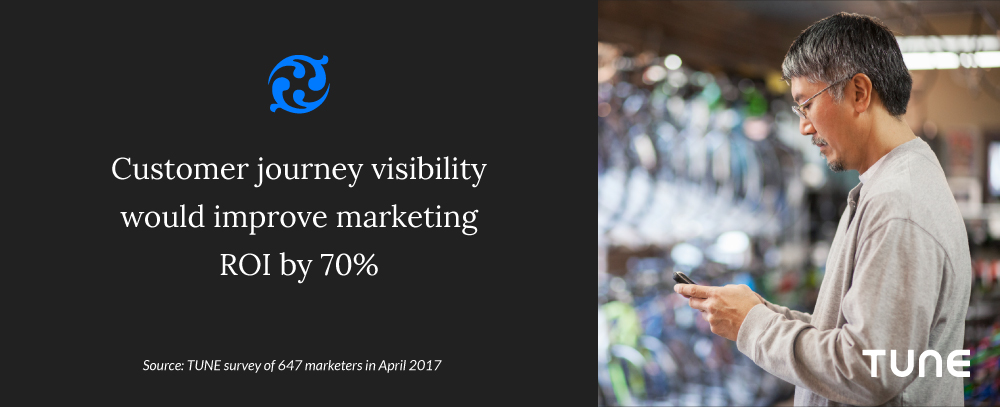
The answer is significant: 70%.
An extra 70% of marketing ROI would drive average profit per dollar of marketing spend from $1.09 to $1.85 — much more attractive. And if a marketers could drive 70% better revenue numbers, a baseline 1:5 ratio of marketing to revenue would jump to $8.50 of revenue for every $1 of marketing expense.
That’s clearly much more attractive, and it says everything we need to know about how important marketers think it is to see and understand the customer journey.
From funnel to journey to … brain? (almost)
While there’s clearly value in seeing, understanding, and measuring the customer journey, achieving that goal is far from easy for most marketers.
Marketers have long understood the movement from prospect to customer fairly simplistically: with a funnel.
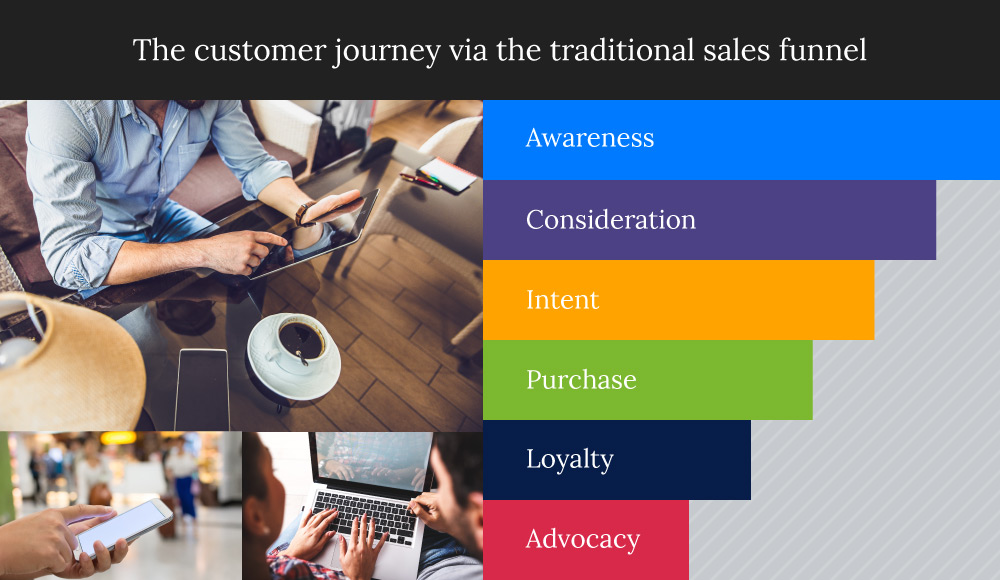
Gartner recently re-envisioned the funnel from awareness to purchase to advocacy as a customer journey, which is a better depiction of the stages marketers would like customers to progress through — and the actions marketers would like customers to take. This depiction highlights customer activities in and around three areas: buying, owning, and advocating.

There’s still a challenge, however. And that challenge is reality, in all its complexity.
“Rather than a funnel, where all are pushed through a narrow hole, the metaphor now is a brain. Every person has many connections…“Warren Whitlock, top 10 social media influencer
The 1,000-step customer journey
The modern digital ecosystem is complex. Very complex. In fact, I talked to a consultant who mapped out 800 points on a massive customer journey map for one client.
The funnel model is simple because it has a single direction of flow: down. The journey model is more complex with multiple steps and stages, and no inherently-binding directionality. There’s a beginning and an end, of course, but many routes between them.
Marketers want customers to progress through the journey. And there is progression, many times. But just as often — or maybe more often — there’s regression. Or looping. Or a stall. Or, in a move that delights but also confuses marketers, people jump right from awareness to purchase in just one or two steps.

At the kind of scale where marketers are mapping 800 different waypoints, it’s no longer simple. Measuring and impacting the journey customers make when becoming aware of, purchasing, and recommending their products is challenging at best, impossible at worst. And attempts to do so can meet with complexity, confusion, and failure.
But completion is not necessarily the goal.
Mapping 800 things that might happen to influence a customer may not be necessary. In fact, there’s value even in incomplete data, according to VentureBeat marketing technology analyst Stewart Rogers:
“There is certainly value in mapping the journey, but many challenges exist, and new ones are appearing … These problems are solvable, but they certainly make mapping the journey more difficult than ever before. That being said, even if the data we get from journey mapping isn’t 100% accurate, it is better than having no data at all.”
Stewart Rogers, Director of Marketing Technology, VentureBeat
TL;DR?
The challenges increase with technology, but technology also simplifies the complexity.

Mobile makes journey mapping simple:
Follow Amazon’s lead
Mobile and other new technologies make customer journey mapping more challenging, because they increase the number of options.
But they can also make it simpler.
First, let’s briefly look at the challenges.
The 86% problem: Cross-device multiplied by cross-platform
Marketers have seen the challenge here: A visitor on a website might be the same as a visitor on a mobile website might be the same as a mobile app user, but it’s hard to tell. This leads to 86% of marketers saying that they are unable to reliably measure their customers’ cross-device activity:
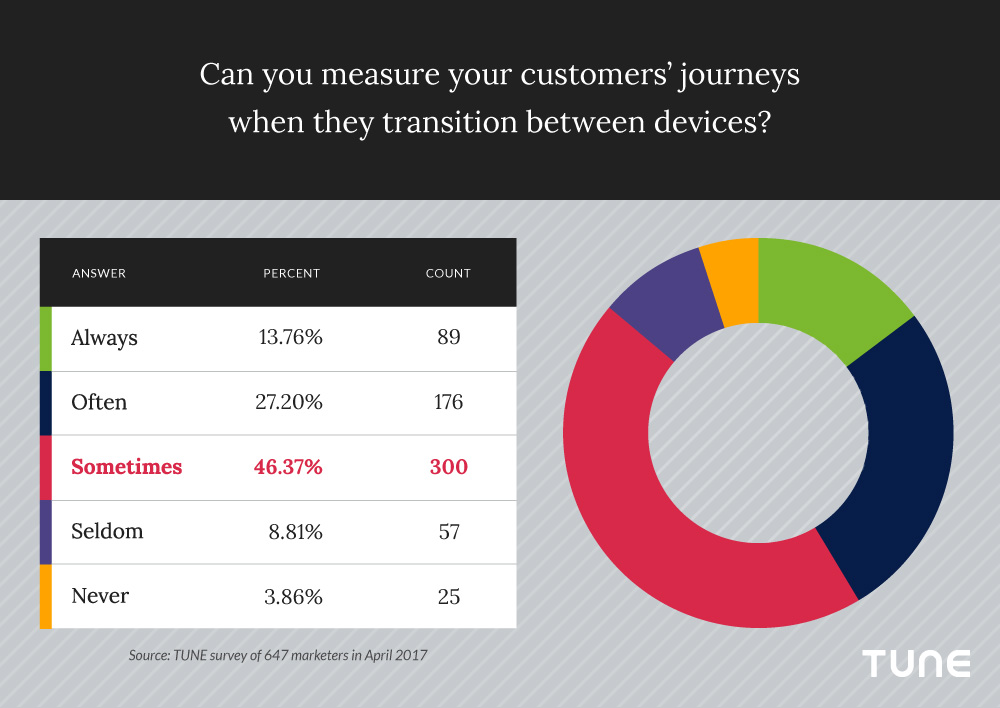
And, in fact, it’s much more challenging than just cross-device tracking, because there’s also cross-platform on single devices.
Just think: On a desktop computer, you might touch a potential customer …
- on your website
- via email
- on Twitter or Facebook
- on a third-party product review website
- via a messaging platform or service
Similarly, on a mobile phone, you might touch a customer:
- in your app
- on your mobile website
- on a social network
- via an email
- via SMS or another messaging platform
Combine those options, many of which occur in real-world scenarios, and you’ve got thousands of potential journeys in a customer’s exploration of your brand and your products across desktop, mobile, real world, social shares, face-to-face word of mouth, smart TV, wearable technology, and other channels and waypoints.
De-duplicating all of these touches and resolving them down to a single individual is a massive task.
“Just as we start to get closer to hyper-personalization, and 1:1 marketing, new devices and channels appear that make it almost impossible to understand who is using the device. Smart TVs and connected cars do not identify an individual persona in the same way a smartphone, tablet, or laptop likely does, and that makes it hard to target the right content at the right time.”Stewart Rogers, journalist, analyst, and speaker for VentureBeat
But privacy…
If it’s not blindingly obvious already, it should be: Privacy matters. Both your customers’ data and data about people who are not yet customers need to be treated with caution, respect, and care.
Staying legal is important. But just as important is not acting in ways that might be legal but are unethical and not explicitly permitted by the customers you are targeting.
It’s tempting to gather as much first-, second-, and third-party data as you can to improve your marketing. It’s wise, however, not to push the envelope on what’s acceptable.
And … cost & complexity are skyrocketing
Marketers are desperate for technology solutions that will solve their marketing challenges. And there are literally thousands of technology vendors who will gladly take your money and deliver their services.
 The question is, however: How much should you spend? And, how many tools do you need?
The question is, however: How much should you spend? And, how many tools do you need?
We asked marketers how much of their technology budget they would spend to get full and complete visibility of their customers’ journey. The answer was shocking.
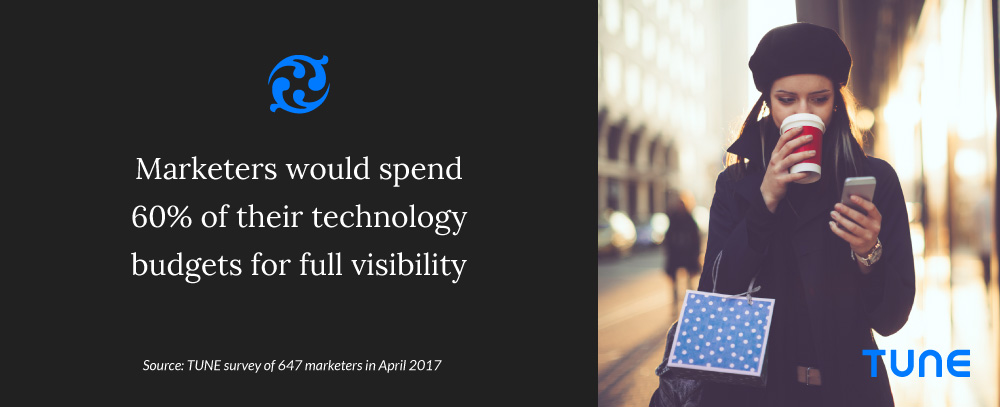
Six hundred and forty-seven marketers told us that they would spend a massive 60.2% of their technology budgets for a tool that would give them full visibility into their customers’ journeys.
The reality, of course, is that it would take much more.
To even approach the 100% visibility level, marketers would need a data management platform. They’d need to instrument everything they do, and everything their companies do — including the product — for data collection at every customer touchpoint. Marketers would also need to buy copious amounts of third-party web, social, demographic, and interest data to enrich their first-party data, plus tools and personnel to match, integrate, normalize, and de-duplicate. Then they’d need to invest heavily in technology and personnel to understand and map all the data.
Oh, and then — given that you might actually want to do something with all this information — marketers would need teams of people to focus on applying the lessons of the data to future marketing campaigns, tweaking and changing regularly as the data indicates.
In other words, this would likely take multiples of even the best-funded Fortune 1000 marketing organizations’ budgets. And even then, it wouldn’t include the pieces where a friend talks to a friend, a decision-maker messages a colleague, or any of the other millions of publicly invisible ways we make decisions.
But there is a better way.
Take the road less traveled: Amazon shows how to win
Let’s assume you do want to know a significant amount of data about your customers’ journeys, but you’re not trying to be Sauron’s all-seeing eye. Amazon shows a clear path to success that you can follow.
Be login-worthy
Do you provide enough value for customers that they feel a desire to create an account with you? And enough value that they feel the need to log into your experiences no matter what platform they’re on?
You want to know your customers.
To know your customers, be login-worthy. If you’re login-worthy, you can learn more about how your customers come to you, interact with you, feel about you, and talk to others about you — and you can influence those things. In addition, if you offer multiple products and services, as most retailers and big brands do, you can learn immensely more about what your customers like, what they want, and what they need, in aggregate and down to finer and finer groups.
Amazon solves for that by offering services that matter.
On the retail side, it’s order status and archived items and one-click ordering. On the media side, it’s music and movies tailored to your experience. On the convenience side, it’s personal assistance from Alexa for your smart home and smart life.
What do you offer that’s comparable?
Be download-worthy
For the exact same reason, you need to be download-worthy.
Your mobile app is not for all your customers, but it is for your most loyal and passionate and profitable customers.
There’s no more personal computing a device than the modern mobile phone, and brands that win disproportionately live on this “three-foot device” … never more than three feet from your body. This is precisely how Amazon has won — as we showed in our Unicorn Dinosaurs report, Amazon has more than 750 million mobile customers: people who use Amazon mobile apps.
That’s more than 4X all of its competitors combined:

That gives Amazon unprecedented marketing power in both understanding its customers and in promoting its products and services to them. The result is obvious to anyone who has been watching retail in any way over the past decade:

Amazon captured over 6X more value growth than all of its competitors combined in the June 2015 to June 2016 year.
That’s impressive. And that’s the power of mobile.
Knowing your customer is marketing dialed to 11
A logged-in experience means you travel the same path as your customer.
But it’s important that this experience be organic to your brand and native to your product.
Marketers can perform circus tricks and play gimmicks with contests to get people to take action, sign up, and log in, but these will always have a limited shelf life. They can be valuable as a tactic, but they require ongoing injections of cash and creativity, and they don’t drive long-term behavior.
What drives long-term behavior?
A service, product, or presence that people want to be part of. Not to lease, or rent, or even to own, but to incorporate into their lives. That means brand is critical, but it also means product and customer experience is critical.
That’s marketing dialed to 11, because knowing your customer means you know what kind of customers you have, and which kind of customers are best. And that means you know something about how to find people who look like your best customers. The true beauty of turning marketing to 11 in this way is that you can accomplish these immensely important strategic imperatives without gathering huge amounts of third-party data on random people, looky-loos, and tire-kickers.
In other words, without invading people’s privacy.

The modern customer journey:
Opportunities & challenges
There’s a reason venture capitalists have dumped billions of dollars into marketing technology startups and contenders over the past five years.
Marketers need that technology run their campaigns, send their emails, build engaging mobile experiences, and … understand the customer journey.
Technology shows marketers 2X more journey data points
Marketers have faith in the power of technology. Perhaps too much faith.
A thousand marketers told TUNE that without modern marketing technology, less than half of the customer journey is visible. Via old-school methods like coupons, TV ratings, offer codes, in-store traffic statistics, phone calls, net promoter scores, and much more — some of which are still very valid — marketers believe that they have visibility into about 41% of the customer journey.
That seems optimistic, but that’s what marketers said.
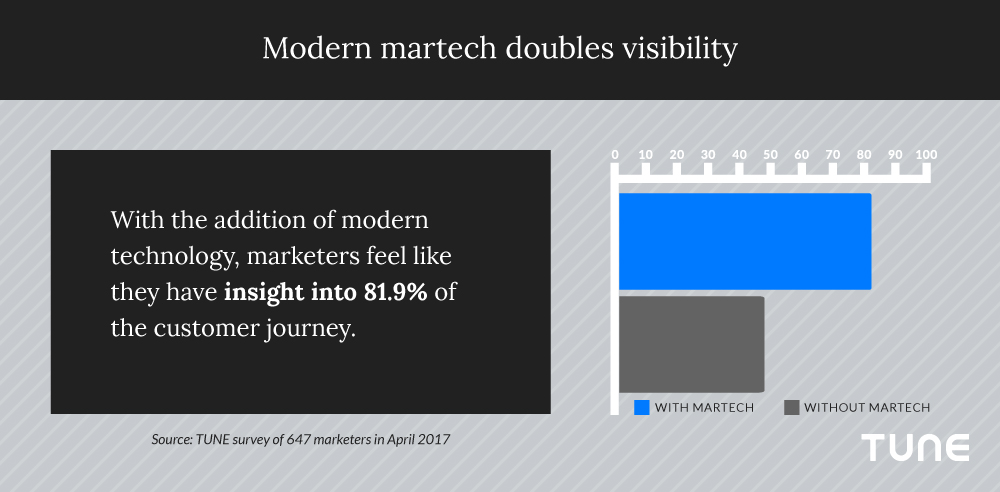
With the addition of modern technology — cookies, traffic logs, IP address detectors, unique identifiers on mobile devices, social monitoring, web buzz monitoring, marketing automation systems — to tie it all together, marketers feel like they have insight into 81.9% of the customer journey.
Again, I think marketers might be buying the Brooklyn Bridge here, but the point is not exactly how much visibility martech offers, it’s how much increased visibility martech enables.
How: Logging in on mobile web & mobile apps
One sure way to increase customer journey visibility is to be login-worthy, as discussed above.
The customer journey doesn’t end at purchase: that’s in a sense the beginning. Getting the second purchase, and making a first-time customer a loyal repeat customer, is arguably more important than initial success.
And that can happen both on mobile web and mobile apps.
Mobile apps have advantages in user interface, capability, and usability. Mobile web has the advantage of ubiquity, a low barrier to entry — and one thing that brands often forget. If someone is logged in to your site or service on desktop, that often translates to them being logged in to your service on mobile web, thanks to people saving passwords in Chrome (which is tied to a Google account, not a specific device). Or, to similar technology on Mac OS X and iOS: Keychain.
In either case, logging in is easier, and therefore so is understanding your customers and your customers’ needs.
How: Smart products
Earlier we talked about the value of customers logging in. But it’s not always obvious from a customer perspective why they should sign up and log in.
That’s why it’s critical to design product experiences — aka customer experiences — in such a way that logging in generates obvious, instant, and massive value.
Think smart home devices, like Sonos.
Logging in is just part of the natural, normal, required, and obviously valuable customer experience. That means product registration is close to 100%, and that bridges the deadly retail gap between a brand and its customers: connecting end users with brands in a way that enables brands to deepen the relationship, improve the service, increase share of wallet, and increase likelihood of being the brand of preference after a natural product lifecycle.
In essence, it transforms a product into a service, and transforms a one-time-payment service into a subscription model.
No, it’s not necessarily a true subscription model — I don’t keep paying for my Sonos.
But, as I upgrade and add new components, Sonos benefits financially, driving a de facto SaaS model where in reality none exists. And, as all startups know, subscription revenue is worth double or triple one-time revenue, because the cost of customer acquisition is so low.
The question becomes: How can you design your product similarly?
“Driving customer experience in the ‘use’ cycle, particularly building the journey from use and mere satisfaction to love, loyalty and advocacy is most valuable. A company that can acquire customers but cannot retain them or encourage positive word of mouth will always struggle. Meanwhile, a company that can retain and grow customers that share with others can improve not only its marketing efficiency but also its bottom line. Brands like Starbucks, which is the second largest restaurant brand in the nation despite spending less than half of the other top-five restaurant chains, demonstrates how loyalty and advocacy converts into marketing and business success.”Augie Ray, Research Director covering customer experience for marketing leaders, Gartner Research

Challenges & changes:
Customer journey mapping today
As we surveyed marketers on customer journeys, mapping, and technology, more than a few interesting — and unexpected — insights emerged. And, some new opportunities popped up.
Here are a few of them …
Brand & performance have merged
When 647 marketers rank brand advertising and performance advertising by where they’re most useful in the customer journey and the results are almost identical, that indicates something: we’re entering an era of marketing accountability.
Traditionally, brand advertising introduces a new product or brand to people. Performance advertising encourages them to purchase. And more brand campaigns assist in customer retention and increased share of wallet …
Not anymore. Look how similarly marketers scored them:
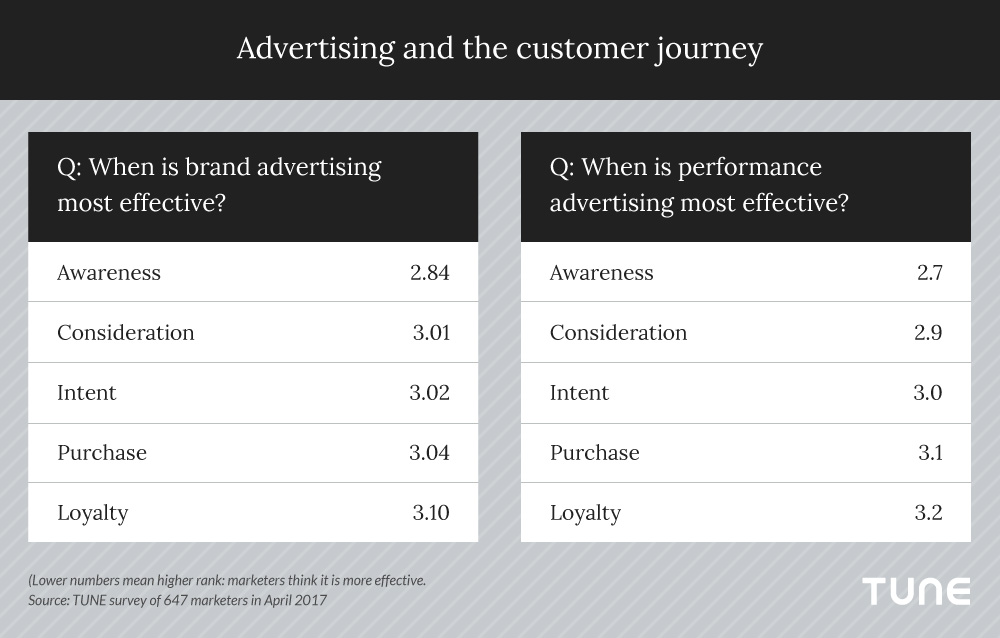
Clearly, marketers are thinking that brand advertising and performance marketing rank equally in the traditional awareness stage of the customer journey.
Also clear: Marketers now expect brand campaigns to return positive ROI, not just positive vibes. And performance campaigns need to boost the brand, not just make money.
There’s a hole in the funnel: Consideration, intent, purchase
By far, awareness and loyalty are marketers’ favorite areas of the funnel. These stages of the customer journey get most of marketers’ first-place votes when we asked them where both performance and brand advertising are most useful.
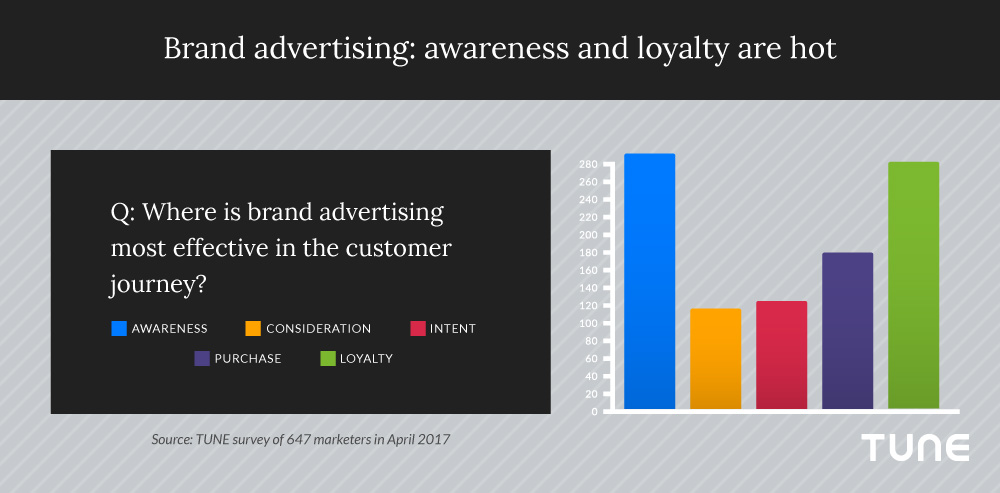
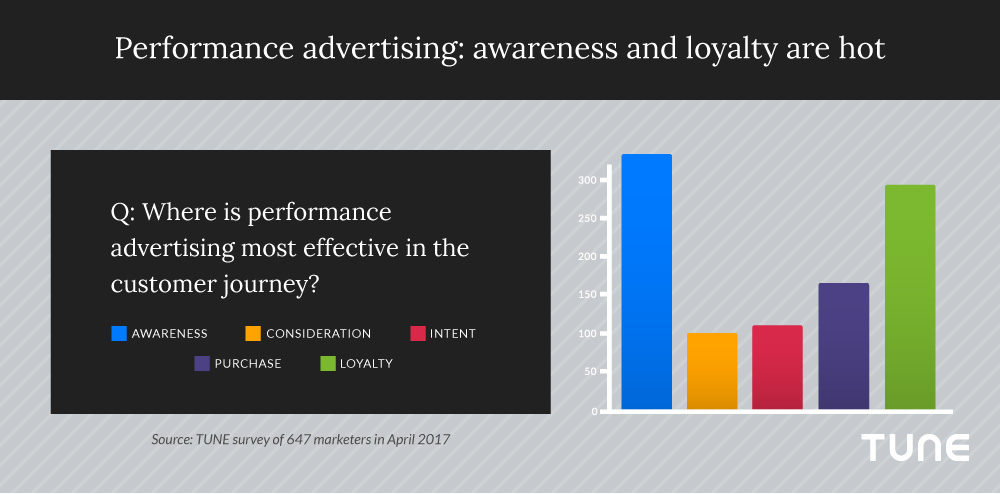
What about consideration? Intent? Purchase? Marketers are largely ignoring them.
For brand advertising, these three stages — 60% of the customer journey — get only 42.4% of first-place votes. And for performance advertising, this 60% of the journey gets only 37% of the first-place votes.
So maybe there’s a hole in the funnel … but it just may be warranted.
No one can do business with you before they know about you in some way. And loyalty is critical, as current CMO and former Forrester analyst Cory Munchbach says:
“The most influenceable and most valuable is the loyalty phase, and yet arguably the one most neglected and underfunded. The data points proving this out are rife, and yet it doesn’t seem like the trend changes much – discrete teams are responsible for discrete phases of the life cycle even though each phase has an impact on the others.”Cory Munchbach, VP Marketing at BlueConic, former Forrester analyst
That said, there’s also something to be said for the point of purchase where performance advertising can be most effective — and where we do see a bump in marketer interest. And, arguably, our modern focus on nurture marketing helps carry prospects from awareness into loyalty.
A core architectural flaw in most marketers’ tech stacks
Out of all a company’s many functions and divisions, marketing stands isolated as a core and key function that does not have a single system of record.
Finance has a system of record: whatever accounting software the company has chose. Sales has a system of record: CRM. And business management, HR, and other divisions have a system of report, an ERP system.
Marketing? Not so much.
Only 9% of marketers have a single system of record
Modern marketers deal in data. Prospects, customers, and fans are defined by who they are, how they feel about the brand, and what they do. But most marketers completely lack the central glue that ties together all the information they have: a system of record.
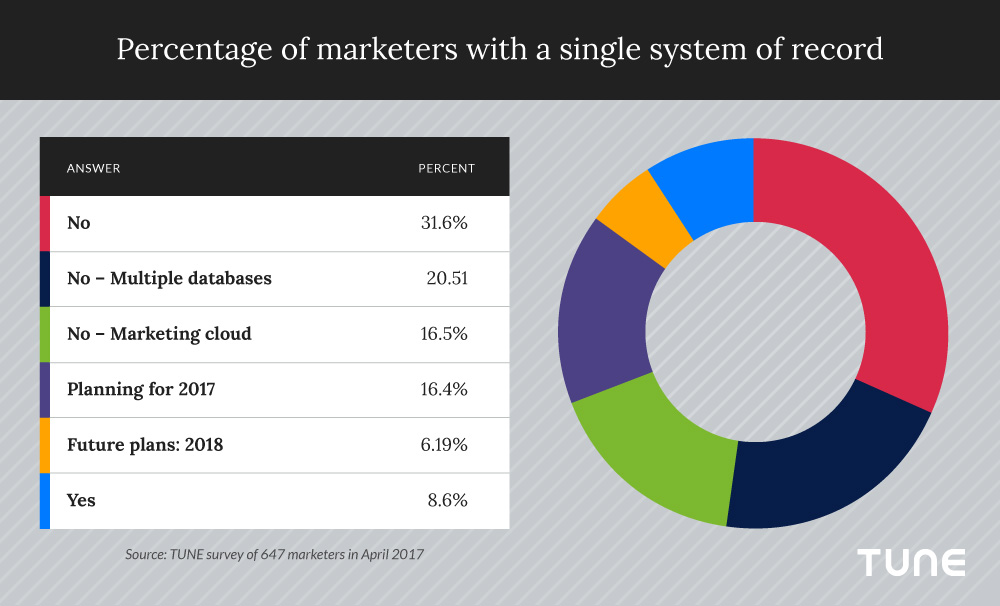
Modern customers pop up on companies’ websites, in their mobile apps, on their social feeds and outposts, in their email, in their stores, and in multiple other places both digital and offline. In addition, smart marketers look for data deeper into the customer journey, post-sale, so they can measure customer satisfaction, Net Promoter Score, and likelihood of customers becoming advocates. So marketers need data about product usage, service issues, and more.
All that data needs to come together in one place — literally or via API — so marketers have a complete view of their customer across the entire marketing and product lifecycles, and can make it actionable via technologies of engagement in mobile, on the web, in email, and all the other ways that companies communicate to prospects and customers.
The reality, however, is that very, very few marketers actually possess that today.

Summing up:
The marketing tech of the future
Valerian & the city of a thousand channels
We talked about complexity, but in the famous words of Bachman-Turner Overdrive, you ain’t seen nothing yet.
While the ad world seems to be coalescing around two major platforms owned by Google and Facebook, reality is more complex than that. And, new technologies are arising that will serve to further disaggregate consumers’ experiences of brand.
We’ve already talked about mobile and the cross-device and cross-platform challenges it entails. In addition, VentureBeat’s Stewart Rogers talked above about wearables and car operating systems and smart TVs.
And now, platforms are extending into other realms.
Google, Amazon, and Apple have been building inroads into what we might call a HomeOS, to go along with our mobile operating systems, our desktop operating systems, and our car operating systems. Microsoft and many other companies are jostling for space here as well.
Add to this virtual reality and augmented or mixed reality, and the almost certain proliferation of smart glasses in perhaps five to 10 years, and you’ve got a FaceOS as well. Critically, FaceOS will literally be the window through which we view the world, offering enormous power to Google, Facebook, Apple, Microsoft, and others in terms of what we see, what we pay attention to, and how that attention is monetized.
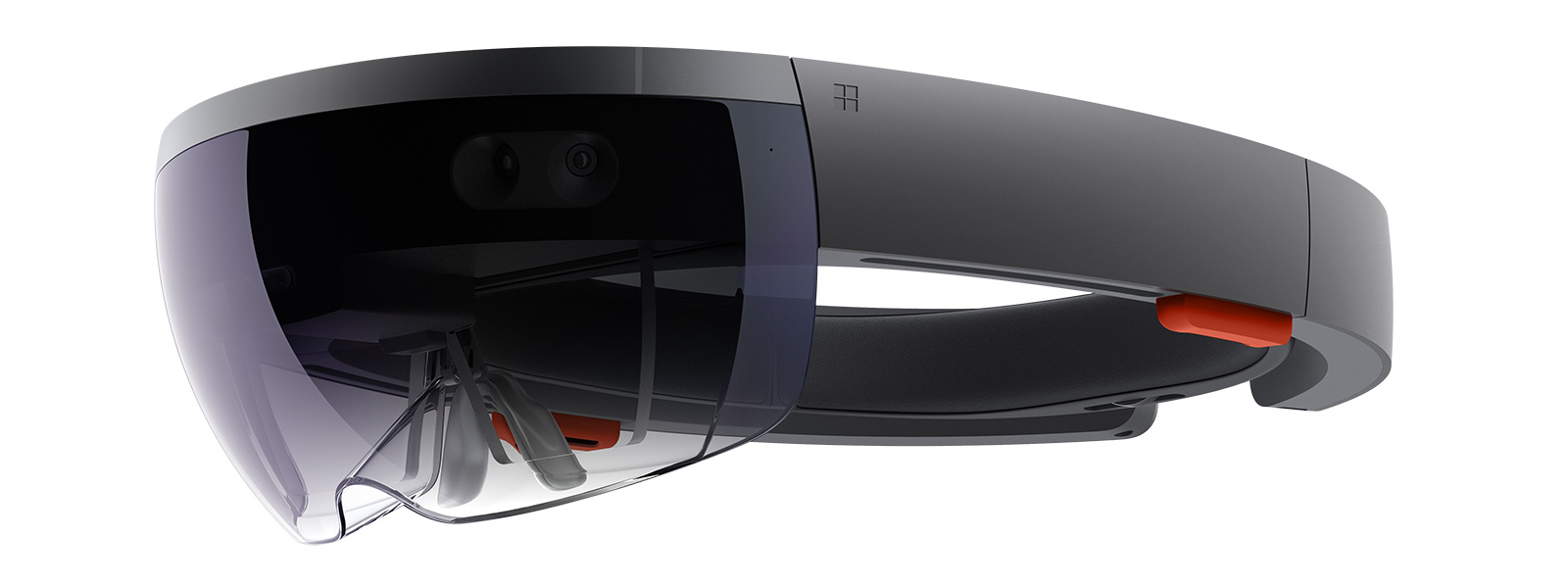 And we haven’t even started talking about personal assistants, which already take our food orders, book us tickets, reorder basics, and increasingly manage both our digital and our physical lives.
And we haven’t even started talking about personal assistants, which already take our food orders, book us tickets, reorder basics, and increasingly manage both our digital and our physical lives.
Add it all up, and we’ve got increasing complexity, multiple platforms that marketers need to pay attention to, and fragmentation of audience.
Merging moments & offers
In this emerging complex reality, the concept of mobile moments remains valid.
Mobile moments are those unique points in time and space when consumers are looking for something specific that they need — a product, an idea, a piece of information — and brands have an opportunity to answer that question, fulfill that need, or stimulate a deeper interaction.
That’s when smart marketers will present offers.
Not necessarily offers in the sense of promotions or discounts, but offers to engage. Offers to get value. Offers to solve a need, fix a problem, answer a question. Offers to put up a hand and get noticed. Essentially, offers to go beyond the very surface of awareness with a brand, and get a step or two deeper in the funnel.
Those offers could be via augmented reality in a game on a futuristic form of Microsoft’s HoloLens. They could be a chat with a representative in a very meatspace in-person event. It doesn’t really matter which one.
What matters is matching interest and need at the right time with the right offer, with the right degree of engagement: not too intense or too fast, but at the speed and intensity that the customer wants.
Owned data in a central repository
We already saw that only 9% of marketers can manage all the data they need to in one unified place.
Smart marketers of the future will measure and manage these mobile moment touches in a single system of record that they can use to be intentional and intelligent about engagement: saying and doing the right things proactively as opportunity presents itself, and reacting intelligently and contextually when prospects reach out.
They won’t do that alone, however. They will have help.
AI & the emergent customer journey
Today, most customer journey tools are prescriptive and deductive. That won’t be the case forever.
Prescriptive and deductive journey builders ask a marketer to design experiences and routes throughout the customer journey. In a simplistic world, this works: the number of variables is low, the journey is clear and obvious, and the marketer can encompass it all mentally and transfer it into software instructions.
However, in a complex and fragmented world, this becomes more and more difficult, perhaps trending to impossible.
Where current journey builders map the journey and expect customers to follow the map, future customer journey tools will be emergent. They will watch the mobile moments. They will see app engagement, email opens, clicks, attention, requests for information, invitations to offers, store visits, event attendance, adds to shopping carts, purchases, and social interactions. They will respond when prospects and customers raise their hands. They will measure what happens, when, and where.
And voila: The result, visualized over time, is the emergent customer journey. Customers are in control, marketing AI watches and responds, and marketers will tune as needed.
Data used in this report
TUNE surveyed 647 marketers in March of 2017 in industries such as healthcare, finance, transportation, retail, telecoms, publishing, manufacturing, government, education, broadcasting, and more. All were U.S. residents. 63.2% were female; 36.8% were male, and their ages ranged from 18 to over 54, with 60% in the 25 to 45 range.
All data contained in this report is aggregated and anonymous. References are provided for informational purposes only and TUNE makes no representations as to accuracy, completeness or timeliness, and disclaims any liability or responsibility to any third parties based on the use of this report. All opinions reflect judgments made as of the original date of publication.
